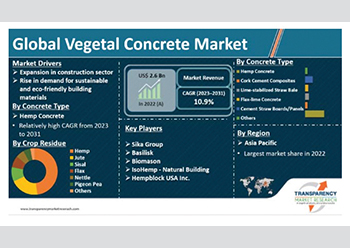Vegetal concrete helps achieve green goals
01 April 2023
Vegetal concrete, derived from biomass or agriculture waste, provides high potential for decarbonisation of buildings, due to their attractive performance characteristics. These attributes include high thermal comfort, carbon neutrality – or more appropriately carbon negativity – and hygrothermal behaviour that make them suitable green building materials, according to a report by Transparency Market Research, a global market research company.
The increasing awareness of the need to reduce the negative impact on the environment of the production and use of traditional concrete is expected to boost the growth of the vegetal concrete market, which is expected to surpass $6.5 billion in value globally by 2031, says the report. This growth will be further fuelled by government legislation stipulating sustainable construction practices and the use of green building materials, it adds.
Global greenhouse gas emissions from human activities are a major concern among policy makers in several countries – with building and construction contributing significantly to these emissions. Companies who aspire to improve their sustainability credentials need to pay attention to the carbon footprint of buildings across all stages – from construction, operation, and demolition, the report says.
Transparency Market Research states that the built environment generates 39 per cent of global carbon and a large chunk – around 28 per cent – relates to energy from building operations alone. Of the various materials used, cement is ubiquitous, and is estimated to contribute to eight per cent of the global CO2 emissions.
Investors in the building and construction industry are taking these figures seriously, encouraging companies to adopt various carbon sequestration methods to meet their sustainability credentials. Mandatory Environmental, Social, and Governance (ESG) disclosures by these companies require them to seek green building materials, of which biomass-made material vegetal concrete is drawing burgeoning interest.
The vegetal concrete market has thus seen tremendous developments in regard to industry research on novel compositions, their mechanical and physical properties, and their overall performance.
The wide array of biomass or agriculture waste used to make vegetal concrete includes hemp, jute, flax, nettle, pigeon pea, and sisal. These crop residues and agroforestry wastes are moulded in the form of aggregates which are then coalesced into cementitious matrix using mineral binders.
Hemp concrete, for instance, with pure lime-based binders can sequester more than 307 kg of CO2 per cu m. The net carbon emissions of this category of vegetal concrete are negative, says the report.
Research aimed at enhancing the carbon-negative impact of vegetal concretes has led to innovations in binder compositions. A pioneer in this field is India-based start-up GreenJams whose patented vegetal concrete called Agrocrete is likely to influence commercialisation of novel carbon-negative building materials in the market. Agrocrete is claimed to be the proprietary, award-winning material behind the world’s first carbon-negative load-bearing block. The company claims that its product has 0.1 kg CO2 per kg of embodied carbon.
Research continues on enhancing the thermal properties and mechanical characteristics of hemp concrete, which will pave the way to green building materials that can be used to build masonry walls. Studies on the durability of vegetal concrete could lead to development of final concrete products that can be used in wide range of building structures such as roads. In addition, development of binders that can improve the compressive strength of hemp concrete will open up new avenues for firms in the vegetal concrete market.
Other vegetal fibres, such as prickly pear, pine needle and banana fibres, are being studied to evaluate their durability and hardness, and flexural and splitting tensile strength, with other criteria being fire and earthquake resistance. This apart, new techniques that maximise the durability of recycled building materials are likely to open up significant business opportunities for companies in the vegetal concrete industry.
However, adopting these biomass-derived materials is not sufficient to fulfil ESG requirements. Methods and strategies of carbon capture need to encompass the entire cement industry. Regulations that mandate construction companies to evaluate the environmental impact of various cement mixes are likely to take off in a big way in the next generation of urban construction in Europe and Asia Pacific by the end of this decade, says the report.
Implementation of green building initiatives has laid the foundation stone for a carbon-neutral built environment. What is also required is advancement in geoengineering coupled with smart building design to reduce the carbon footprint of the entire structure – not merely of individual building materials, the report concludes.
- Circular technologies the way forward
- JV aims for future of low-carbon concrete
- First DAC-to-concrete facility on way
- New PCM process to keep homes cool
- Vegetal concrete helps achieve green goals



